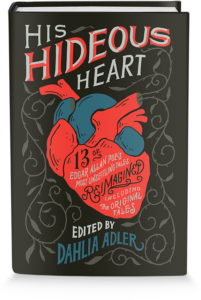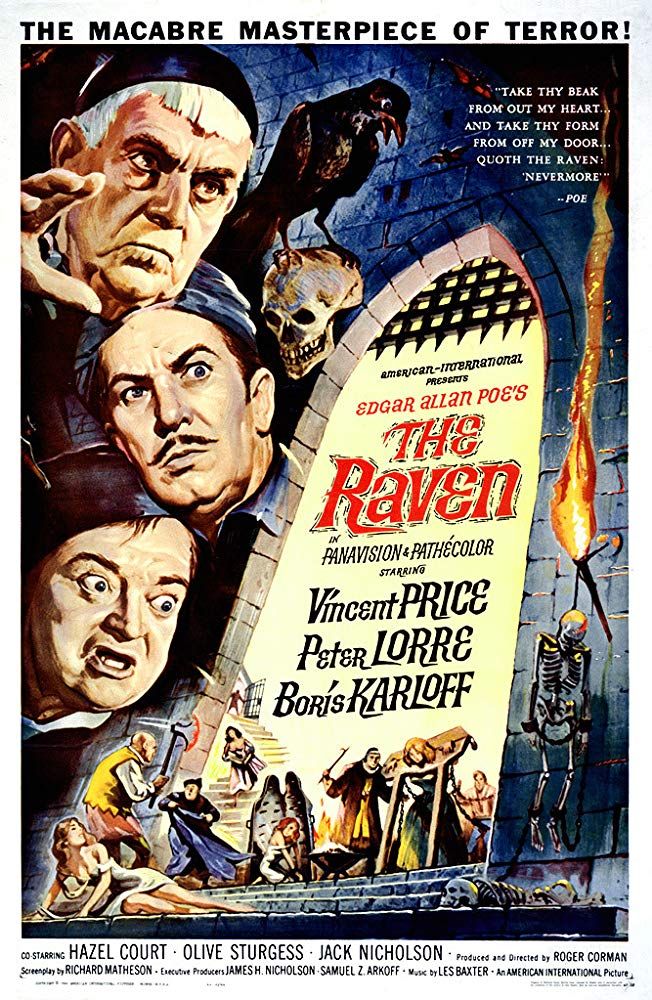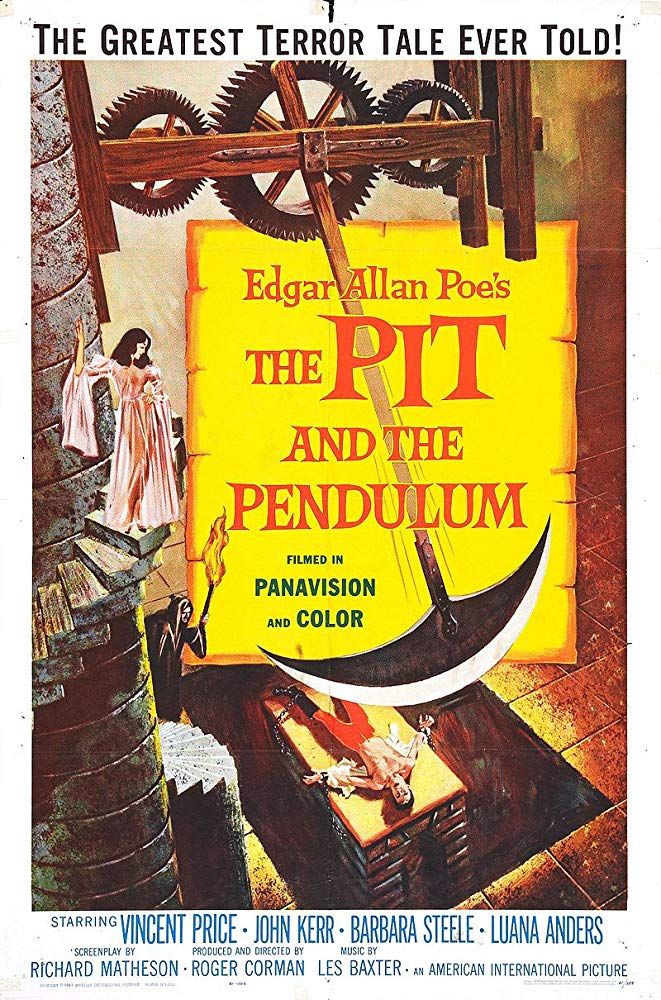
Roger Corman and Vincent Price’s Edgar Allan Poe Movies
This post on Edgar Allan Poe movies is sponsored by Flatiron Books, publishers of His Hideous Heart, a collection of 13 of Edgar Allan Poe’s most unsettling tales reimagined.

In the 1960s, director/producer Roger Corman made several Edgar Allan Poe movies, nearly all starring Vincent Price and collectively known as the Corman-Poe Cycle. I love these movies.
Edgar Allan Poe’s life was tragic; his stories and poems, sad and haunting. The movies are joyful.
The History of the Corman-Poe Cycle
American International Pictures (AIP, originally American Releasing Company) was formed in the 1950s and focused on movies catering to a teen audience. Roger Corman and Alex Gordon were the principle producers. Their first film was The Fast and the Furious (not that one).
According to the AIP publicity department, the winning formula for a successful motion picture was what they dubbed “The Peter Pan Syndrome”:
a) a younger child will watch anything an older child will watch;
b) an older child will not watch anything a younger child will watch;
c) a girl will watch anything a boy will watch;
d) a boy will not watch anything a girl will watch;
therefore:
to catch your greatest audience you zero in on the 19-year-old male.
Obviously this is disgusting and incorrect, but it has become common thinking in nearly every industry and it explains most of AIP’s output.
Between 1960 and 1965, eight movies were made in the Corman-Poe Cycle. Seven were based on Edgar Allan Poe works; 1963’s The Haunted Palace was an adaptation of H.P. Lovecraft’s The Case of Charles Dexter Ward, with the title changed and a voice-over added as a framing device, using text from Poe’s poem “The Haunted Palace.” Seven starred Vincent Price; The Premature Burial starred Ray Milland.
The Complete Corman-Poe Cycle
House of Usher (1960): based on the short story “The Fall of the House of Usher.”
The Pit and the Pendulum (1961): expands upon the short story “The Pit and the Pendulum.”
The Premature Burial (1962): based on the short story “The Premature Burial.”
Tales of Terror (1962): based on the short stories “Morella,” “The Black Cat,” “The Cask of Amontillado,” and “The Facts in the Case of M. Valdemar.”
The Raven (1963): expands upon the poem “The Raven.”
The Haunted Palace (1963): based on H.P. Lovecraft’s novella The Case of Charles Dexter Ward, using the title from Poe’s 1839 poem.
The Masque of the Red Death (1964): Based on the short story “The Masque of the Red Death,” with the short story “Hop-Frog” used as a subplot.
The Tomb of Ligeia (1965): Based on the short story “Ligeia.”
I re-watched three of them, and reread the original Poe works. My thoughts on the adaptations follow.
The Raven
Poe’s most famous poem (followed closely by “Annabel Lee”) is arguably a tale, like many of his tales, of madness. The narrator hears an incessant tapping and finds a raven, who refuses to answer his questions about his lost love Lenore, only tapping and saying “Nevermore.”
My favorite stanza:
But the Raven still beguiling my sad fancy into smiling,
Straight I wheeled a cushioned seat in front of bird, and bust, and door;
Then, upon the velvet sinking, I betook myself to linking
Fancy unto fancy, thinking what this ominous bird of yore—
What this grim, ungainly, ghastly, gaunt and ominous bird of yore
Meant in croaking, “Nevermore.”
The Movie
In The Raven, Vincent Price plays Erasmus Craven, a magician mourning the death two years prior of his second wife, Lenore. He vamps about the room, taking being sad to almost professional levels, while ominous music plays. This music, which is extremely not good and plays nonstop throughout the entire movie, sets the mood as ridiculous rather than spooky, which is…a choice. Eventually Erasmus is interrupted by a literal raven tapping at his literal window, and when he lets it in, it speaks to him—but this raven does not say “Nevermore.” Instead, Peter Lorre’s voice berates Erasmus to break the enchantment he is under. And so, in under five minutes, we leave the plot (such as it is) of the poem behind and go into the plot of the movie, written by Richard Matheson.
The plot is, in a word, absurd: after Erasmus finds the ingredients for the potion to return Bedlo to his human form (somewhat delayed because the list includes things like spiders and “we’re vegetarians”), Bedlo tells him that he saw Lenore, alive and well and at the castle of magician Dr. Scarabus, the very one who turned Bedlo into a raven in the first place. The two magicians go to Scarabus’s castle with Craven’s daughter Estelle (Olive Sturgess) and Bedlo’s son Rexford (Jack Nicholson, yes that one). Along the way they face diabolical mind control, and at the castle things get more complicated when we learn that Bedlo tricked Erasmus into coming because Scarabus wants to learn the secret of his magic (which looks…exactly like Scarabus’s magic). AND IT KEEPS GOING FROM THERE, SOMEHOW. Oh, and by the way? Scarabus is played by Boris Karloff. Yeah, it’s that kind of movie.
But what’s the tone?
No attempt is made to be serious at any point in this movie, except perhaps by dear Vincent Price. In addition to the aforementioned mood music, the special effects look like someone decided to make Bedknobs and Broomsticks on a shoestring budget (which is, honestly, a fair assessment of the magic in The Raven—although Bedknobs and Broomsticks would not exist until 1971).
Sadly, at no time during the movie does Erasmus call Bedlo a “grim, ungainly, ghastly, gaunt and ominous bird.”
The Pit and the Pendulum
I’m beginning to think Poe was a little preoccupied with the topics of madness and death. This story is a 20 page fever dream–like narrative of a man condemned to death as he faints and then slowly comes back to consciousness, trying to piece together what happened and where he is. (He is a prisoner of the Inquisition, having been put on trial for unspecified crimes.) He explores his prison: he almost falls into the pit—but doesn’t; he wakes up strapped to the table below the pendulum—and at the last moment, escapes! Finally, the walls start to close in and he is forced to the edge of the pit—and France is liberated! The end! (Uh. Spoilers.) He swoons a lot and it’s kind of bonkers, especially considering how many times food and water show up.
The Movie
Sometimes called Pit and the Pendulum (without the initial “The”), the movie takes the title of the story and almost nothing else, imagining what comes before the death sentence (but ignoring the little context that is given in the story). Watching it felt distinctly like watching one of the Hammer Films noir thrillers written by Jimmy Sangster. Screenwriter Richard Matheson, who I honestly think was a total hack, seemed to be interested in exploring the psychological effects of witnessing something truly terrible as a child and being haunted by it repeating in adulthood. Unfortunately, Matheson does not seem to have known absolutely anything whatsoever about psychology (to be fair, Sangster didn’t either, but he was a better screenwriter) (also to be fair, the Hammer movies were being made at the same time as the Corman-Poe Cycle, and both reflect the attitudes and beliefs of the time, which were straight-up appalling).
Pit and the Pendulum is set in Spain, which we only know because main character Francis Barnard (John Kerr), an Englishman, calls his hosts (Vincent Price and Luana Anders) Don and Doña Medina. (Everyone speaks with an American accent.) In it, Barnard arrives at a castle on the sea and demands to see Medina and learn the circumstances of the death of his sister, who married Medina. Medina’s sister lets Barnard in and they tell him a cockamamie story about his sister, Elizabeth, dying of a rare blood condition. Their friend Dr. Leon, who tended to her, joins them for dinner and immediately spills the beans that Elizabeth literally died of fright.
But wait, there’s more.
The Medinas then show Barnard the LITERAL TORTURE CHAMBER in their basement and admit that she LOCKED HERSELF IN THE IRON MAIDEN and died. WHAT. Then we learn that the castle is maybe haunted by Elizabeth, and THEN, in a series of awkward flashbacks, Doña Medina explains to Barnard that her brother witnessed their father killing their mother in that very torture chamber when he was a child. IT ONLY GETS WEIRDER FROM THERE. Eventually, in the last five minutes of the movie, we get to see the pit (we never really see how deep it is) and the pendulum, as Medina, having gone (more?) mad when he learned that Elizabeth was alive the whole time and now believing himself to be his actual father, straps Barnard in and attempts to murder him.
This movie is actual horror, unlike The Raven, and the music (by the same composer) is appropriate to the mood. The dialogue is terrible, the characters are wooden, and only Don Medina is given anything resembling motivation. (There are also two servants, who mostly just lurk; one of them, Maria, occasionally functions as a spring-loaded cat, which is fun; the other is in the opening, lurks throughout, and then acts as a sort of a human deus ex machina.) As always, it’s 100% worth watching for Vincent Price’s earnest performance. And for the final shot of the movie, which I won’t tell you about because I think you should also watch the 80 minutes preceding it.
The Masque of the Red Death
“The Masque of the Red Death” is a strange little story about Prince Prospero, also referred to as a duke, who shuts himself and all his friends up in his castle to avoid a terrible plague that is sweeping the nation (not disco). A few pages are devoted to describing the suite of seven rooms in which Prospero throws parties, and the pendulum clock that chimes ominously at the hour; then an uninvited guest arrives at a party and Prospero attempts to kill him, only for the guest to turn on Prospero and kill him, because SURPRISE! it’s the plague.
“Hop-Frog” opens with a description of a fat king who loves jokes, goes on to describe a disabled little person who the king thinks is a joke, and is otherwise really gross and fatphobic and ableist. Hop-Frog gets revenge on the wicked king by tricking him into a very elaborate murder plan.
The Movie
Watching this movie felt almost exactly like I remember LSD feeling. (If my mom is reading this, I am obviously kidding.)
Unlike the comedy of The Raven and the attempted psychological horror of Pit and the Pendulum, The Masque of the Red Death goes full on horror in the vein of Hammer Films again, but this time much closer to the films they are best remembered for. Also unlike The Raven and Pit and the Pendulum, Masque was written by Charles Beaumont and R. Wright Campbell, who seem to be far less allergic to dialogue than Matheson. The music is by David Lee, while the other two movies were scored by Les Baxter.
Look, I don’t know if this movie is better than the other two because different people worked on it; I don’t know if this movie is better than the other two at all! It is certainly less fun than The Raven. But it feels like a whole movie, and not just something the gang threw together on the weekend. I love B-movies and I love movies the gang threw together on the weekend, but sometimes I like a movie that feels like someone actually thought it out and executed their vision. This is that movie.
Was “executed” a pun?
(Not a deliberate one.)
As I said, Masque is full-on horror. There’s no more tiptoeing around with magic or trauma here; Vincent Price stars as Prince Prospero, who (because the story wasn’t interesting enough, I guess) has literally sold his sold to Satan. The red death is a plague that is overtaking the country, just as in the story. Prospero taunts the peasants and burns a village when he finds that the red death is there…but when two men object, he orders them taken to his dungeon, and when peasant girl Francesca (Jane Asher) objects to him taking away her father and boyfriend, he takes her to the castle intending to corrupt her (not like that) (probably). So, those seem like good ways to catch the plague? But what do I know.
Prospero has trouble corrupting Francesca to the ways of Satan, because her Christian faith is so strong. Prospero’s girlfriend Juliana (Hazel Court) is jealous of Francesca, helping her to escape with her men and then telling Prospero of their escape attempt. Then Juliana gets pecked to death by a falcon (PECKED. TO DEATH. BY A FALCON.) and it’s just like, a normal thing that happens? Meanwhile, Prospero invites all of his friends to a masked ball to celebrate not having the red death. BUT GUESS WHO SHOWS UP AT THE BALL, THAT’S RIGHT, IT’S YER BOY THE RED DEATH. The end!
What a weird movie. But very good! But so weird.
Wait, what about Hop-Frog?
Oh yeah, he was one of Prospero’s entertainers—renamed Hop-Toad—along with a ballerina who I believe was meant to be a little person like Hop-Toad (the story is inconsistent about her size), but was played by a child dancer whose voice was dubbed by an adult woman. Hop-Toad straight-up murders a guy who was an asshole, in a similar but slightly less contrived manner as in the story. WHEW. I am not clear why this was chosen as the B-plot, but okay.
Conclusion
Gee golly, I love B-movies, and these are some B-movies.
Also In This Story Stream
- Delirium and Delight: The Poetry of Edgar Allan Poe
- 13 Songs Influenced by Edgar Allan Poe
- 12 YA Recommendations Based On Your Favorite Poe Poem
- Why Edgar Allan Poe Makes a Cameo in Anya Seton’s DRAGONWYCK
- 10 Neo-Gothic YA Novels for Edgar Allan Poe Fans
- 13 Edgar Allan Poe Read-Alikes For The Smallest Ravens
- I’m Poe-pular: Edgar Allan Poe in Popular Culture
- 17 Signs That Your Tinder Date Might Be Edgar Allan Poe
















